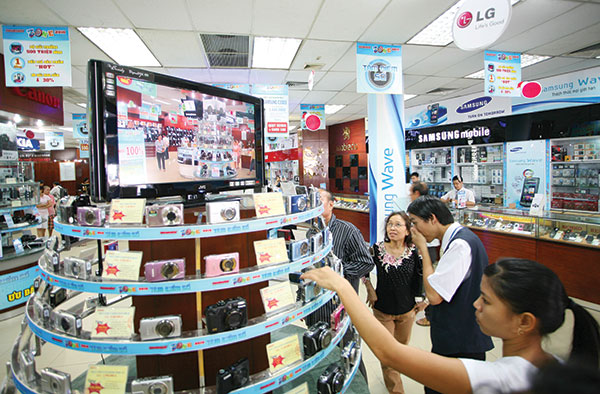More energetic label reforms needed
 |
| The Ministry of Industry and Trade’s try at energy labelling reform is already taking heat for not going far enough, Photo: Le Toan |
Do Huu Hau, general director of German lighting product producer Osram Vietnam, told VIR that the Ministry of Industry and Trade’s (MoIT) Circular No.36/2016/TT-BCT, which cuts down on the process of energy labelling, still has problems. Number one on the list is the amount of discretion given MoIT and relevant agencies to examine firms at any time they like.
The new circular’s Article 8 stipulates: “Periodically or on an unscheduled basis, MoIT [can] combine with relevant agencies to examine enterprises’ energy labelling activities.”
“What do ‘periodically’ and ‘on an unscheduled basis’ mean? This regulation gives a free hand to MoIT to inspect enterprises at any time. That’s unfair,” Hau said.
A source from Japanese-invested Panasonic Vietnam’s legal team told VIR that Circular 36 gives MoIT and relevant agencies “unfair leverage in inspecting enterprises”.
“Inspectors can visit our company at any time without any notice. That’s unfair as it will surely affect the company’s performance,” the source said.
Promulgated in December 2016, the circular took effect on February 10, 2017, replacing MoIT’s former energy labelling legislation, Circular No. 07/2012/TT-BCT issued in April 2012.
Under Circular 07, which had been criticised by AmCham Vietnam and many enterprises in the country, enterprises needed to submit an energy-labelling dossier to MoIT to obtain a certificate for each product model. The process took 15-20 days. After obtaining the certificate, enterprises could have the product labelled.
Circular 07 also made it much more difficult to label products produced overseas. For such items, inspections needed to take place in the production country. MoIT required its examiners go to the production country to carry out the testing, with costs paid by enterprises.
Under the new Circular 36, enterprises are given free rein to conduct their own energy labelling. They will also be responsible for the accuracy of the labels on their products.
Circular 36 also allows testing for energy self-labelling by independent testing organisations and laboratories of both domestic and foreign producers. But these testing standards must be in line with those of MoIT.
This condition has also drawn some criticism. Nguyen Viet Ha, managing director of the Vietnamese branch of US-backed investment consulting firm BowerGroupAsia Inc., told VIR that this regulation “can be problematic for testing activities at overseas-based labs, as these labs’ standards are not always suitable to those in Vietnam”.
“MoIT should allow the application of globally-recognised energy efficiency standards,” Ha said. “MoIT should also allow world-famous products like Apple, Dell, Canon, Sony, Samsung, and HP not to be tested in energy efficiency and labelled under Vietnam’s standards, as they have already been tested in international-standard labs.”
“Products sourced from developed nations such as the US, South Korea, Japan, European nations, and from multinational groups should not be constrained by this regulation,” Hau said.
What the stars mean:
★ Poor ★ ★ Promising ★★★ Good ★★★★ Very good ★★★★★ Exceptional
Latest News
More News
- HEINEKEN Vietnam partners with Ho Chi Minh City Traffic Police on road safety drive (December 17, 2025 | 09:42)
- BUV and China’s CSCSE sign MoU to boost educational cooperation (December 17, 2025 | 08:00)
- PVT Logistics honoured with ‘Fast Enterprise Award’ at APEA 2025 (December 16, 2025 | 18:22)
- Empowering Sustainable Data Centers with Smart Infrastructure Solutions (December 16, 2025 | 13:59)
- Vietjet wins gold ESG transport sustainability award in Taiwan (China) (December 13, 2025 | 22:03)
- Legal framework completed for national digital transformation (December 13, 2025 | 21:55)
- SOAR initiative launched at TECHFEST Vietnam 2025 (December 13, 2025 | 10:00)
- Mondelez Kinh Do secures fourth Top 100 Sustainable Company nod (December 13, 2025 | 09:00)
- Vietnam advances three-pillar strategy to prevent cervical cancer (December 12, 2025 | 20:00)
- MCH shares secure approval for listing on HSX (December 12, 2025 | 12:59)


















 Mobile Version
Mobile Version